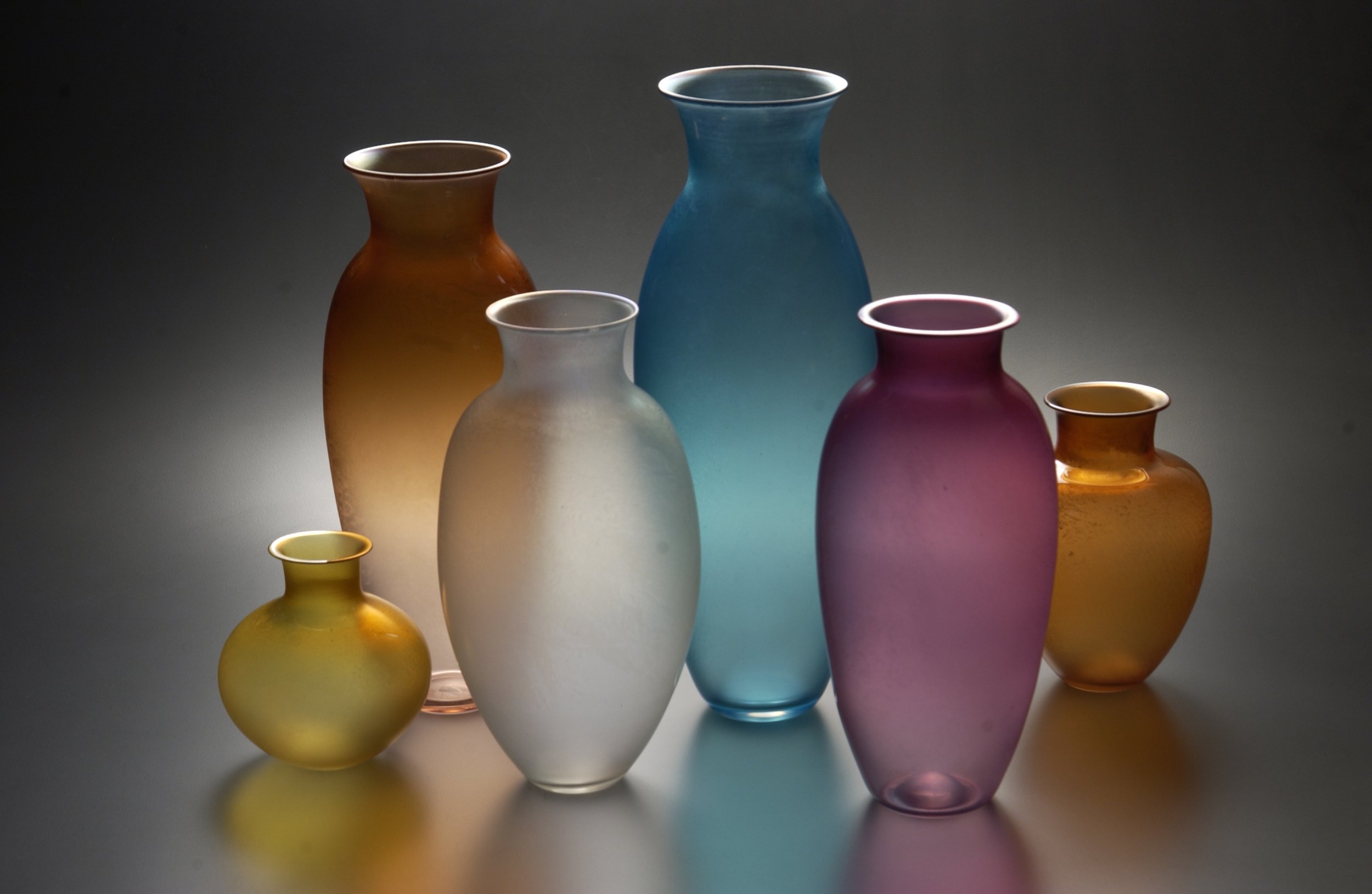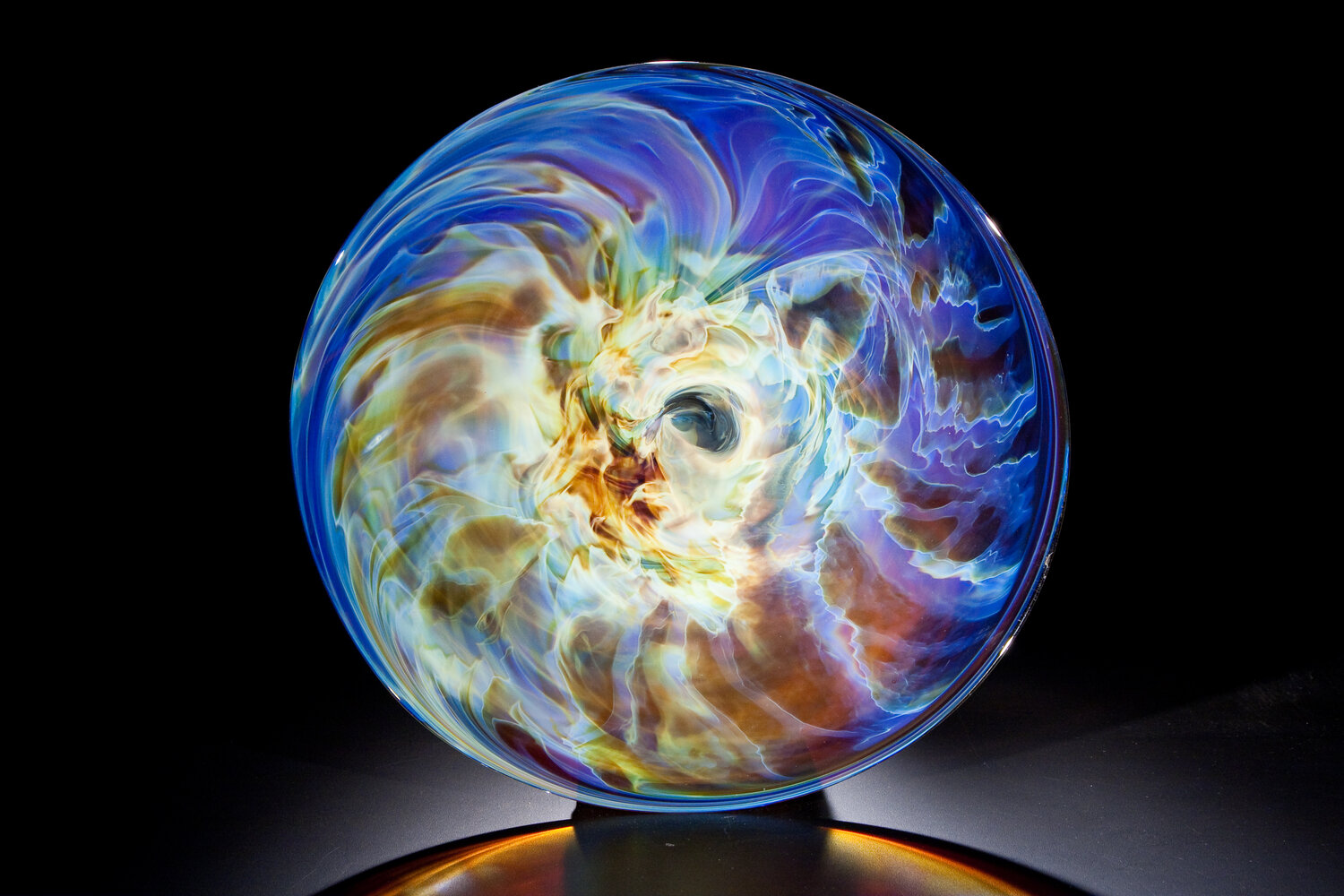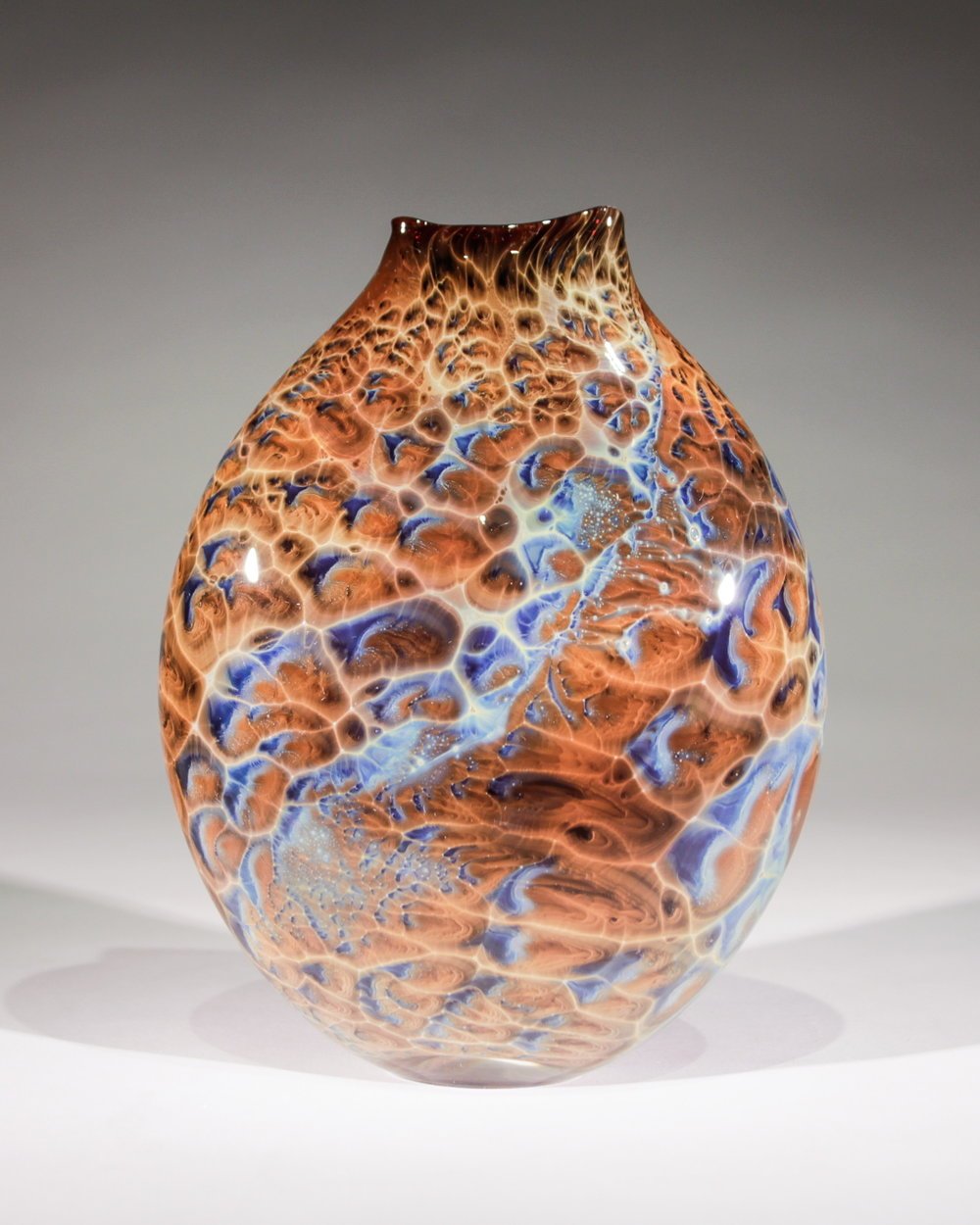Facts & Glossary
Signature Simpson Glass
-

New Mexico Glass is a variegated crystalline blue glass full of swirling currents and pinpricks of light. The vibrant patterns are reminiscent of a starry night or even a map of the stars, or they might also resemble Hubble Telescope photos of great nebulae, topographic maps of dramatic alien terrain, and/or a stormy ocean full of turbulent waters and crashing waves. New Mexico glass is made by melting metallic silver onto the molten surface of a dark glass, then carefully controlling the temperature and flow of oxygen and propane into the glass furnace as the piece is formed, thereby enhancing and enriching the color.
-

Corona Glass is a substance that Josh first developed by experimenting with glass chemistry in the mid-80’s. When molten, this unpredictable material is affected by temperature, humidity and many other factors, but when everything works out well, the resulting glass contains swirls and splashes of vibrant color. Its final appearance can be like a splash of liquid fire, an eddy of melted light, or an exploding galaxy such as one might see in Hubble Telescope imagery.
-

Tektite Glass is a gnarly lava-like material that Josh derived from the chemical formula of a real glass meteorite. This substance has an uncooperative mind of its own. Josh can coax and guide it, but ultimately the strong-willed glass takes its own shape. In Tektites and Portal sculptures, the artist contrasts this coarse exterior material against the elegance of New Mexico, Corona, and Iridescent glass interiors.
Simpson Glass Series
-

Planets are solid glass imaginary worlds that might exist in distant galaxies and universes. They contain continents teeming with life, mountains and forests, winding rivers, sandy beaches, and swirling oceans. Often clouds or spaceships drift in the atmosphere above. Planets range in size from as small as 1.75” diameter to Megaplanets that may be larger than 12” and weigh more than 100 lbs.
-

Inhabited Planets are worlds that contain some evidence of habitation, such as structures, cities, or signs of advanced technology, while Possibly Inhabited Planets contain no clear evidence that civilizations reside there… but they leave this possibility to our imagination.
-

Cloud Planets (aka Waterworlds), are unlike classic Simpson Planets that are made with opaque New Mexico or Corona glass. Instead, these worlds have translucent cores and an aqueous appearance, with vaporous clouds above and rafts of colorful cane floating within each misty world.
-

Inhabited Vases combine Planet techniques and ideas with the functionality of the vase form. Looking closely, you may see spaceships circling in the outer layers of the piece or you might notice other themes from Planets – including evoking an undersea world – as well as ideas from New Mexico Glass and Iridescent work. Many are made with a traditional vase shape but with a very thick layer of glass in the body (containing layers upon layers of scenery) combined with a delicate lip.
-

Iridescent Vases give Josh a way to play with pure form and color. The iridescence is created by exposing a vessel’s molten interior to a weak acid, which results in a rich and permanently etched surface that refracts and reflects the light surrounding it.
-

Stellar Disks are large platters on which Josh expresses his ideas about the appearance of the night sky and the working of the universe. New Mexico Platters resemble either starry night skies or peaceful or crashing seas. Corona Platters are reminiscent of photos taken of deep space phenomena such as nebulae and the formation of stars. Hyperspace and Spacetime Platters explore astrophysical concepts such as black holes, gravitational lensing, and the warping of the space-time continuum.
-

Tektites are sculptures made from lava-like glass that Josh originally created by replicating the chemical composition of actual glass meteorites. Within their rough, contorted exterior Josh had laid in lustrous layer of iridescent, New Mexico or Corona glass, creating the effect of a large meteorite having burst open, only to reveal a gleaming, secret, magnificent interior.
-

Tektite Portals have a rough, meteor-like exterior of Tektite glass, enclosing a spherical inner realm made visible through a perfectly smooth window cut to reveal the entire, complex universe within, almost like gazing through an aircraft window at outer space or through a marine porthole at a marvelous undersea world.
-

Saturns explore the idea of planets ringed by swirling matter or, most recently, black holes surrounded by swirling energy. Each one consists of a large thin disk of glass – either concentric rings, New Mexico or Corona glass – in “rotation” around a central planet or black hole. This continuation of the Planet theme involves a rigorous procedure that requires the help of the whole hotshop and hours of focused labor.
-

Red New Mexico Glass, which resembles the red rock landscapes of the American Southwest or perhaps even the planet Mars, results from first adding copper into the raw glass mixture and then dramatically reducing the oxygen in the reheating flame.
-

Desert New Mexico Glass looks like sunny, sandy landscapes. Created by applying reactive silver to clear glass, this glass changes color from dusky gold to rich blue when viewed against a dark background or filled with a dark liquid.
-

Other-Colored New Mexico pieces present Simpson’s classic variegated New Mexico patterning on translucent ruby, orange, green, and other colors of glass. Sometimes these works also receive an iridescent treatment, creating added depth and sparkle.
Simpson Glass-Making Terms
-

Cane is a rod made of bundled strands of glass that have been arranged in patterns and layers, then heated, fused, and stretched to form thinner and thinner rods that contain the same pattern, but in miniature. Josh uses cane to form the imaginative structures, details and spaceships within Planets, as well as to create the stretched lattice patterns of Spacetime Platters, Bowls and Vases.
-

Spaceships are tiny imaginary spacecraft Josh creates from segments of his own handmade cane, which he later sets into orbit in the atmosphere of Inhabited Planets.
-

“Josiah Simpson” signature on a piece of Josh’s glass indicates that it is one of his favorites, usually because it turned out very much like what he had in mind while making that piece… or sometimes because it’s just especially beautiful even if different from his plan.
-

Furnaces are where raw glass mixtures are melted (or re-melted) and the glass is kept molten at about 2,000-2,300 degrees Fahrenheit in large ceramic “crucibles.” Josh operates as many as five furnaces full of different formulas and colors of glass. Each furnace was either built or designed by Josh himself.
-

Glory Holes are empty furnaces used to reheat glass as it is being formed on the blowpipe. Some glassblowers use their glass furnaces also to reheat their work as it is being made, but Josh’s large glory holes allow him to create his very largest platters and sculptures, while small glory holes are where Josh makes spaceships from single rods of cane.
-

Blowpipes are hollow steel tubes used to pick up a “gather,” i.e. a molten glob of glass, from the glass in the furnace. They usually have a plastic mouthpiece at one end (to prevent burning one’s lips) and a slight flare at the other end to better hold the gather of molten glass.
-

Pontils are solid steel rods used to transfer a piece of glass off the blowpipe. When the pontil is attached to the outer end of the blown molten glass piece, this enables the glass to be “cracked off” the blowpipe so that the hollow end of the glass is now open and available for further shaping and working. In this way, what started out as a closed bubble with a tiny opening at the end attached to the blowpipe can be taken off the pipe and shaped into an open bowl, vase, or platter.
-

Marvers are steel tables that are ground and polished perfectly flat. Molten glass (often on a blowpipe or pontil) is pressed or rolled against this surface to be shaped and sculpted. Josh uses a Marver when making cane from multiple layers of colored glass.
-

Forming blocks are wood chunks that have been carved into a bowl shape, used to shape molten glass into a spherical form. Created in a variety of sizes and sometimes with a long handle, blocks are usually made from the dense wood of a fruitwood tree. Before use, they are submerged in water and soaked for weeks or longer, to prevent them from bursting into flame when in contact with the hot molten glass.
Orders & Shipping
-
Order Processing
All items on our website are in stock and ready to ship. We make every effort to ship orders within 2 business days (Monday-Friday). The Studio is closed weekends and some holidays; orders placed during these times will be handled the next business day. During the holiday season or other busy times, processing may be longer.
-
Special Orders
Special orders for items not available online are possible. Fulfillment time depends on availability, lead time, and the Studio schedule. Contact rebecca@megaplanet.com to discuss needs and timeframes.
-
Domestic Shipping
Domestic orders are shipped via UPS or USPS Standard Shipping. We will select the best shipping method for your order and location; you may indicate a preference when placing your order. Delivery is typically within 7-10 days, but may take longer during the holiday season. Standard shipping times are estimates only and not guaranteed. If you require expedited shipping, please Contact Us prior to placing your order.
-
International Shipping
We ship internationally via United States Postal Service. Please call the Studio for shipping quotes and to place international orders. Shipments outside of the USA may be subject to duty, import tax, or customs fees; these fees are the responsibility of the customer and are beyond our control.
-
Expedited Shipping
If you require expedited shipping, please call the Studio before placing your order so we may give you a quote for available shipping options. We are happy to accommodate rush shipping whenever possible during our regular business hours. Our fluctuating carrier pick-up times and daily demands of the studio may affect shipping option availability.
The studio is closed weekends and some holidays. We are not available to take calls or ship orders on these days.
-
Returns & Refunds
Josh wants you to love your glass! We accept returns for refund or studio credit on a case-by-case basis. Please call or email the studio within 30 days of receiving your order for return approval before sending your item back. Upon receipt, we will inspect the returned item to ensure it is not damaged. Once the return is approved, we will contact you to complete the transaction. We do not refund original or return shipping costs. If your order arrives damaged, please let us know immediately so we can replace or refund the item!
